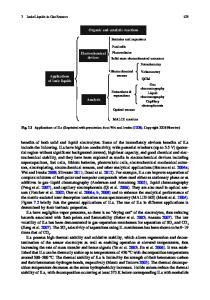Polyaniline Protonation and Deprotonation Process as the Main Mechanism for Ionic Field Effect Sensors
- PDF / 518,303 Bytes
- 6 Pages / 432 x 648 pts Page_size
- 90 Downloads / 282 Views
Polyaniline Protonation and Deprotonation Process as the Main Mechanism for Ionic Field Effect Sensors José Renato Alcarás, Hugo J.N.P.D. Mello and Marcelo Mulato. Department of Physics, Faculty of Philosophy, Sciences and Letters at Ribeirão Preto, University of São Paulo (USP), Brazil. ABSTRACT In this work, Polyaniline (PANI) was used as a sensing film for pH measures due to its characteristic of switching protonation states under acid and alkaline solutions. Equally produced films had their sensitivity (electric response versus pH) measured before and after being under the influence of a constant electric potential (from 3.5 to 6 V, one for each film) for the analysis on how the electric potential influenced the sensitivity. Then, the protonation caused by the application of the first potential was reversed by applying a constant 5 V reverse potential and the sensitivity was then evaluated again. The results show, on average, a constant relation between intensity of protonation and the potential applied and that the process of protonation is reversible by applying a higher opposite potential then the protonation one. INTRODUCTION Conducting polymers can be used as sensing membranes for studying the chemical properties from different solutions. Polyaniline (PANI) has several oxidation states [1] according to the amount of protons existing in its structure [2]. Emeraldine base polyaniline changes to emeraldine salt (protonated polyaniline, due to an increase in its number of protons) when submitted to a convenient voltage, on acidic solution (electrochemical doping) [3]. PANI can be deposited over convenient substrates using different deposition techniques [4, 5]. Specifically, using a constant current over a period of time (galvanostatic technique) [4], it is possible to estimate the amount of electric charge deposited over the work electrode [6]. Due to this propriety, this method was used to electrodeposit PANI over fluorine tin oxide (FTO) films with a constant amount of charge for every film. An extended gate field-effect transistor (EGFET) can be built as a measurement system for the pH on a solution using a reference electrode. The PANI films are used as work electrodes by extending the gate of a field effect transistor (FET), improving the isolation between the sample and the measurement system [7]. EXPERIMENT PANI films were produced by galvanostatic electrodeposition technique (j = 1 mA/cm² and t = 300 s) over FTO substrates. The evaluation of their sensitivity was made on the IAEGFET system (Figure 1), in which the difference of potential between the work and the
39
reference electrodes was amplified by an instrumental amplifier. The data were computer analyzed.
Figure 1. Scheme of the instrumental amplifier EGFET (IA-EGFET) sensor system.
Figure 2. Left: Scheme of the deprotonation system. Right: PANI-based EGFET characteristic curve (the example is from a film which had not been protonated yet). Then, using an electric potential source, a constant potential (3.5 to 6 V, using steps of 0.5 V) was
Data Loading...









